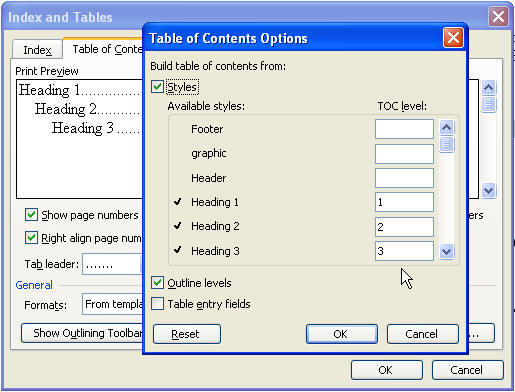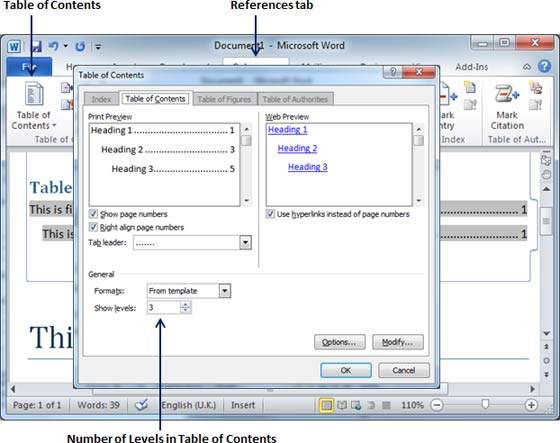

#Microsoft word table of contents options update#
It’s a wise move to fully update the TOC before sending a document out.Īlternatively pressing F9 will also update the ToC because underneath the modern buttons and boxes is an old-fashioned Word field code fields into the document or add entries to a Heading created ToC. It rarely takes a noticeable time to update even on a long document. We prefer to use ‘Update entire table’ to ensure the TOC is fully up to date. This choice is faster but we generally avoid it because a change in the headings, however minor, may be overlooked.

The default is ‘Update Page Numbers only’ which is fine if you’ve not changed or moved any headings – only added or removed text. The Update Table button will give you two choices. Just go through your document, adjust the Heading styles accordingly then click ‘Update Table’.Ī Table of Contents does not update automatically when headings or pagination changes. The pull down menu at left shows the same Table of Contents gallery to quickly change the look of the ToC.Ĭhances are you’ll notice some anomalies in your initial TOC – headings missing or items that should not be there. If you just click OK you’ll get a standard Table of Contents showing headings from ‘Heading 1′, Heading 2′ and Heading 3’ with a heading for the ToC included. In Word 2003 and before you’ll find it under Insert | Reference | Index and Tables | Table of Contents.

Word 2007 and later it’s under the ‘References’ tab on the ribbon. The basics haven’t changed much for many versions of Word. Once you’ve got some headings formatted in your document you can make a Table of Contents. TOC’s are made from Outline Levels a hidden paragraph attribute. It’s a common misunderstanding that Word uses the Heading styles to make the Table of Contents but that’s not strictly true. However, you can assign any paragraph style to a level in the TOC. That’s the easy way and what we’ll use in this article. If you haven’t already, go through your document applying Heading styles to heading and sub-headings.

Normally you’ll use the ‘Heading 1’, ‘Heading 2’ etc styles in Word to define the headings that you want to show in the Table of Contents. Word takes the text from paragraphs in nominated styles to make up the TOC. Preparing your documentīefore you make your Table of Contents (aka TOC) you need to setup your document with headings that will make up the TOC. It’s a good way to see an overview of a long document and ensure that it’s in a logical structure.įinally, it can be a way to jump to parts of the document if you don’t like using the Document Map/Navigation Pane feature in Word. TOC’s can be useful in any long document such as a contract.īeyond the simple Table of Contents there are a lot of extras and tricks that we’ll explain in future articles.Ī table of contents can be there for ‘in house’ use while making the document, and later removed or reduced in the final version. Table of Contents is very easy to do in Word and it’s not just for people who are making books. The look of the dialog boxes and galleries changed with Word 2007 however under those superficial features, the fundamentals are the same. The basic TOC options haven’t changed for a long time. Let’s look at the basic options for making a Table of Contents (TOC) in a Word document.


 0 kommentar(er)
0 kommentar(er)
